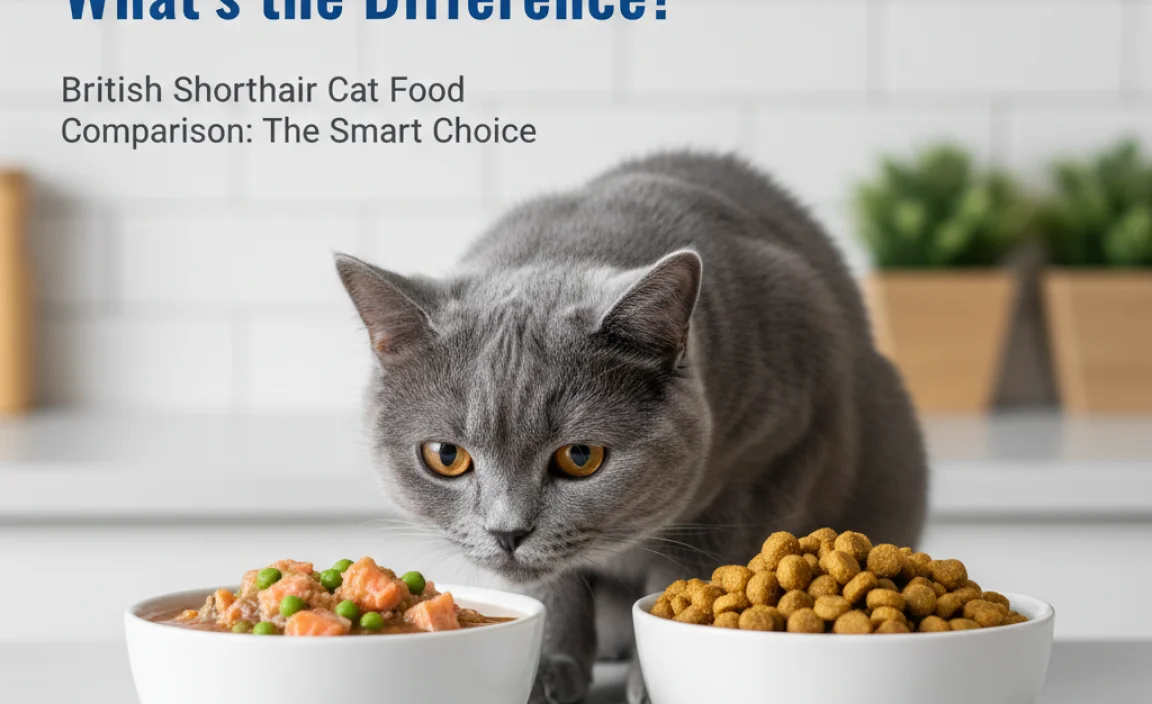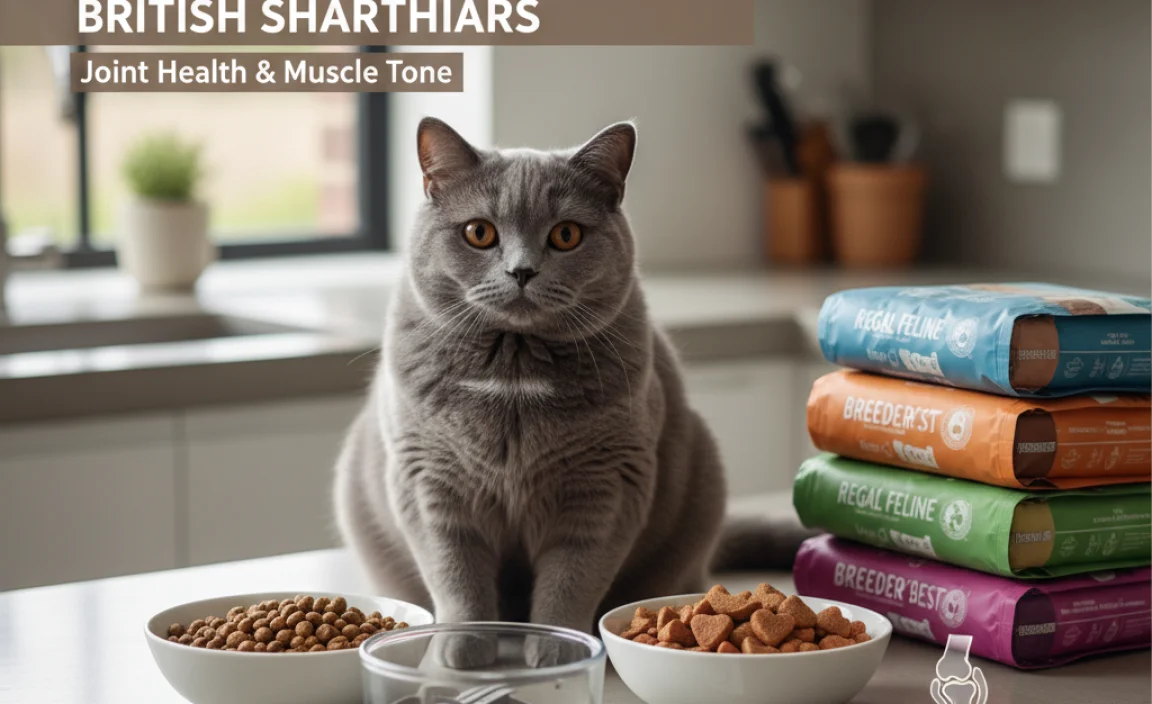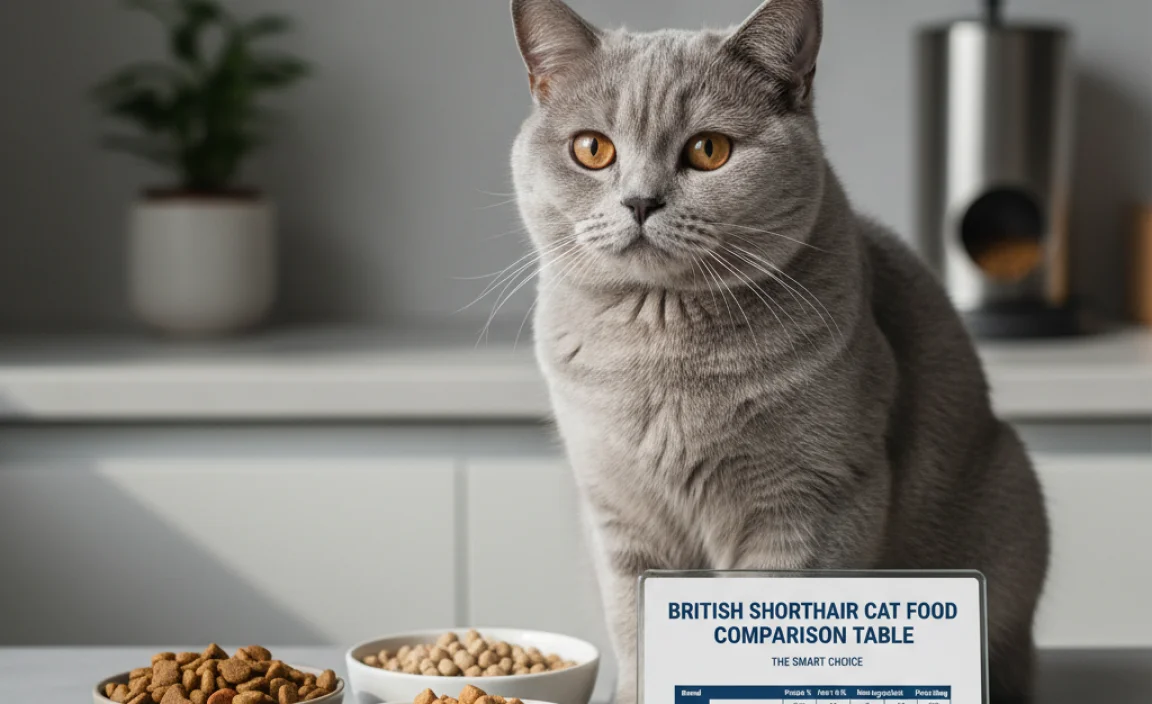British Shorthair Cat Food Comparison: The Smart Choice
Quick Summary: Choosing the right food for your British Shorthair involves considering their age, activity level, and any specific health needs. Look for high-quality protein sources, moderate fat content, and limited carbohydrates. Wet food can help with hydration, while dry food is good for dental health. Always check the ingredient list and consult with your vet to ensure a balanced diet tailored to your cat’s individual requirements.
Finding the perfect food for your British Shorthair can feel like a puzzle. With so many options, how do you know what’s best? It’s a common concern for us British Shorthair owners, and the good news is, you’re not alone! We all want our feline friends to be healthy and happy, and their diet plays a huge role. This guide will walk you through everything you need to consider when choosing the right food, so you can be confident you’re making the best choice for your beloved kitty. Let’s get started on this journey to optimal nutrition!
Understanding Your British Shorthair’s Nutritional Needs

British Shorthairs are known for their sturdy build and relaxed personalities. However, like all cats, they have specific dietary requirements to maintain their health and well-being. Understanding these needs is the first step in selecting the right food.
Protein: The Building Block
Protein is crucial for your British Shorthair. It supports muscle development, tissue repair, and overall growth. Look for cat foods that list a high-quality animal protein source as the first ingredient, such as chicken, turkey, fish, or beef. According to the Association of American Feed Control Officials (AAFCO), cats require a minimum amount of protein in their diet to thrive.
Fats: Energy and More
Fats provide energy and help your cat absorb essential vitamins. They also contribute to a healthy coat and skin. Opt for foods with moderate fat content, as British Shorthairs can be prone to weight gain if their diet is too high in fat. Sources like fish oil and flaxseed oil are beneficial for omega-3 and omega-6 fatty acids, which support skin and coat health.
Carbohydrates: Use Sparingly
Cats are obligate carnivores, meaning they primarily need protein and fat. Carbohydrates should be a smaller part of their diet. Avoid foods with excessive amounts of fillers like corn, wheat, and soy. These ingredients offer little nutritional value and can sometimes lead to digestive issues. Small amounts of easily digestible carbs like rice or potatoes are generally acceptable.
Vitamins and Minerals: Essential Additions
A well-balanced cat food should include essential vitamins and minerals such as taurine, vitamin D, and calcium. Taurine is particularly important for heart and eye health, and cats cannot produce it on their own, so it must be included in their diet. Always check the ingredient list to ensure these vital nutrients are present.
Wet vs. Dry Food: What’s the Difference?

One of the first decisions you’ll face is whether to feed your British Shorthair wet food, dry food, or a combination of both. Each has its own advantages and disadvantages.
Wet Food: Hydration and Palatability
Wet food, also known as canned food, has a high moisture content, which is excellent for keeping your cat hydrated. This is especially important for British Shorthairs, as they may not always drink enough water on their own. Wet food is often more palatable and can be a good choice for picky eaters or cats with dental issues. However, it tends to be more expensive than dry food and can spoil quickly once opened.
- Pros:
- High moisture content
- More palatable
- Easier to eat for cats with dental problems
- Cons:
- More expensive
- Spoils quickly
- Can contribute to dental issues if fed exclusively
Dry Food: Convenience and Dental Health
Dry food, or kibble, is convenient and can be left out for your cat to graze on throughout the day. It also helps to promote dental health by scraping plaque and tartar off the teeth as your cat chews. However, dry food has a lower moisture content than wet food, so it’s crucial to ensure your cat has access to plenty of fresh water. Choose high-quality dry food with a good balance of protein, fat, and carbohydrates.
- Pros:
- Convenient and easy to store
- Helps with dental health
- More economical
- Cons:
- Lower moisture content
- Can be high in carbohydrates
- May not be as palatable for some cats
A Combination Approach
Many owners find that a combination of wet and dry food works best for their British Shorthairs. This allows you to take advantage of the benefits of both types of food. For example, you could feed wet food in the morning for hydration and dry food in the evening for dental health. This approach ensures your cat gets a balanced diet and stays well-hydrated.
Decoding the Label: What to Look For

Reading and understanding cat food labels is essential for making informed choices. Here’s what to look for when evaluating different brands.
Ingredient List: Quality Matters
The ingredient list is where you’ll find the most important information about the food. Ingredients are listed in descending order by weight, so the first few ingredients make up the bulk of the food. Look for a named animal protein source (e.g., chicken, turkey, or salmon) as the first ingredient. Avoid foods that list generic terms like “meat by-products” or “animal digest” as the primary protein source. PetMD offers a comprehensive guide on understanding pet food labels.
Guaranteed Analysis: Nutritional Breakdown
The guaranteed analysis provides a breakdown of the food’s nutritional content, including the minimum percentage of crude protein and crude fat, as well as the maximum percentage of crude fiber and moisture. Use this information to compare different foods and ensure they meet your cat’s specific needs. Keep in mind that these are minimum or maximum values, not exact amounts.
AAFCO Statement: Meeting Nutritional Standards
Look for an AAFCO (Association of American Feed Control Officials) statement on the label. This statement indicates that the food meets the nutritional standards established by AAFCO for a particular life stage (e.g., growth, maintenance, or all life stages). This ensures that the food is nutritionally complete and balanced for your cat. According to the AAFCO website, this statement is a critical indicator of food quality.
Additives and Fillers: What to Avoid
Be wary of foods that contain excessive amounts of additives, artificial colors, flavors, and preservatives. These ingredients offer no nutritional value and can sometimes cause allergic reactions or digestive issues. Similarly, avoid foods with high amounts of fillers like corn, wheat, and soy. These ingredients are often used to bulk up the food and provide little nutritional benefit.
Special Considerations for British Shorthairs

British Shorthairs have some unique characteristics that can influence their dietary needs.
Weight Management
British Shorthairs are prone to weight gain, so it’s important to monitor their food intake and activity levels. Choose a food with moderate fat content and avoid overfeeding. Regular play and exercise can also help to keep your cat at a healthy weight. Consider using a food scale to measure out precise portions and avoid free-feeding.
Hairball Control
British Shorthairs have dense coats that can lead to hairball issues. Look for foods that are specifically formulated for hairball control. These foods typically contain higher levels of fiber, which helps to move hair through the digestive system. Regular grooming can also help to reduce hairballs.
Kitten, Adult, and Senior Diets
Your British Shorthair’s nutritional needs will change as they age. Kittens need a diet that is high in protein and calories to support their rapid growth. Adult cats need a balanced diet to maintain their health and energy levels. Senior cats may need a diet that is lower in calories and higher in fiber to support their digestive health. Choose a food that is appropriate for your cat’s current life stage.
British Shorthair Cat Food Comparison Table

To help you make an informed decision, here’s a comparison table of some popular cat food brands suitable for British Shorthairs:
| Brand | Type | Protein Source | Life Stage | Key Features |
|---|---|---|---|---|
| Royal Canin British Shorthair Adult | Dry | Chicken | Adult | Specifically formulated for British Shorthairs, supports heart health and muscle tone. |
| Purina Pro Plan Focus Adult Sensitive Skin & Stomach | Dry | Salmon | Adult | Good for cats with sensitive stomachs, rich in omega fatty acids for skin and coat health. |
| Blue Buffalo Wilderness High Protein Grain Free | Dry | Chicken | All Life Stages | Grain-free, high in protein, contains LifeSource Bits for added nutrients. |
| Wellness Complete Health Chicken Pate | Wet | Chicken | All Life Stages | Balanced nutrition, supports hydration, good for picky eaters. |
| Hill’s Science Diet Adult Sensitive Stomach & Skin | Dry | Chicken | Adult | Easily digestible, supports digestive health, good for sensitive stomachs. |
Transitioning to a New Food
When switching your British Shorthair to a new food, it’s important to do so gradually to avoid digestive upset. Start by mixing a small amount of the new food with the old food and gradually increase the amount of new food over a period of 7-10 days. Monitor your cat’s stools and appetite during the transition. If you notice any signs of digestive upset, such as diarrhea or vomiting, slow down the transition or consult with your veterinarian.
- Day 1-2: Mix 25% new food with 75% old food.
- Day 3-4: Mix 50% new food with 50% old food.
- Day 5-6: Mix 75% new food with 25% old food.
- Day 7-10: Feed 100% new food.
Supplements: Are They Necessary?
In most cases, a well-balanced cat food will provide all the nutrients your British Shorthair needs. However, there may be certain situations where supplements are beneficial. For example, if your cat has a specific health condition, such as arthritis or kidney disease, your veterinarian may recommend certain supplements to support their treatment. Always consult with your veterinarian before adding any supplements to your cat’s diet. The Cornell Feline Health Center provides valuable information on feline health and nutrition.
Monitoring Your British Shorthair’s Health
Regular vet check-ups are essential for monitoring your British Shorthair’s health and identifying any potential dietary issues. Your veterinarian can help you determine the right food and portion sizes for your cat, as well as recommend any necessary supplements. Pay attention to your cat’s weight, coat condition, and energy levels, as these can be indicators of their overall health.
Conclusion
Choosing the right food for your British Shorthair is a crucial part of ensuring their health and happiness. By understanding their nutritional needs, reading food labels carefully, and considering their individual requirements, you can make an informed decision that will benefit your feline friend for years to come. Remember to monitor your cat’s health, consult with your veterinarian regularly, and adjust their diet as needed to keep them thriving. With a little research and attention, you can provide your British Shorthair with a diet that supports their overall well-being and helps them live a long and healthy life. Happy feeding!
Frequently Asked Questions (FAQ)
1. How much should I feed my British Shorthair?
The amount of food your British Shorthair needs depends on their age, weight, activity level, and the type of food you are feeding. Always follow the feeding guidelines on the food packaging and adjust as needed to maintain a healthy weight. Consult with your veterinarian for personalized recommendations.
2. Can British Shorthairs eat human food?
While some human foods are safe for cats in small amounts, it’s generally best to stick to a diet of high-quality cat food. Avoid feeding your cat foods that are toxic to cats, such as chocolate, onions, garlic, and grapes. Always consult with your veterinarian before offering your cat any human food.
3. What are the signs of a food allergy in cats?
Signs of a food allergy in cats can include skin irritation, itching, vomiting, diarrhea, and hair loss. If you suspect your cat has a food allergy, consult with your veterinarian. They may recommend an elimination diet to identify the offending ingredient.
4. Is grain-free food better for British Shorthairs?
Grain-free food is not necessarily better for all British Shorthairs. While some cats may benefit from a grain-free diet if they have a grain allergy or sensitivity, many cats can digest grains without any issues. Focus on choosing a high-quality food with a good balance of protein, fat, and carbohydrates, regardless of whether it contains grains.
5. How often should I feed my British Shorthair?
Most adult cats do well with two meals a day. Kittens may need to be fed more frequently, such as three to four times a day. Adjust the feeding schedule based on your cat’s individual needs and preferences.
6. What is the best way to store cat food?
Store dry cat food in a cool, dry place in an airtight container to prevent it from becoming stale or contaminated. Once opened, wet cat food should be refrigerated and used within 24-48 hours. Discard any uneaten wet food after this time to prevent spoilage.
7. Can I switch between different brands of cat food?
Yes, you can switch between different brands of cat food, but it’s important to do so gradually to avoid digestive upset. Follow the same transition process as when introducing a new food, mixing a small amount of the new brand with the old brand and gradually increasing the amount of the new brand over a period of 7-10 days.



